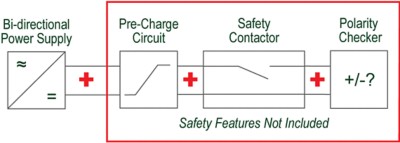Battery Test Safety Requirements
Overview
Safety is paramount in battery testing. When testing batteries that are hazardous by nature, safety should be a major part of your battery test setup.
The details of safety requirements are often something customers think about after purchasing the test equipment. As a result, engineers eventually must integrate external fixtures and control mechanisms, adding to the complexity and cost of their system, not to mention schedule delays.
Let’s discuss three safety features that should be at the top of your list when looking for a battery test solution.
Contents
- Minimum Battery Test Safety Requirements
- Add-On Costs of Safety Features
- NI Battery Test Systems Have Multiple Layers of Safety Built-In
Minimum Battery Test Safety Requirements
Important safety features that are crucial for testing batteries safely and effectively include safety contactors, a reverse polarity checker, and a pre-charge circuit.
Neglecting to implement these safety features leave your battery test setup vulnerable and can lead to catastrophic events, unit-under-test (UUT) damage, and downtime. Bidirectional power supplies as well as many battery cyclers do not include these features.
Let’s discuss the 3 minimum battery test safety test requirements that will keep your battery test set up free of vulnerabilities.
Figure 1: Battery Cycler Includes Safety Contactor, Polarity Checker, and Pre-Change Circuit.
Safety Contactors: Ensures Isolation and Safe “Off” Condition
Safety contactors create a safe “off” condition by providing isolation. Without the contactor, even in an off-state, power flow could still occur with your DUT. That flow could be caused when enough resistance is created between those terminals so that the power source continues to draw current and drain the battery or cause other safety hazards.
NI uses a built-in hermetically sealed safety contactor that is designed into the battery cycling equipment. When our test systems are off, our instruments do not draw power and the contactor physically breaks the connection between the cycler and the UUT.
Polarity Checker: Protects Operator and Equipment from User Error
A polarity checker is necessary to prevent damage to the battery and the equipment in the case of incorrect wiring by the user, which happens quite frequently. A built-in reverse polarity checker prevents inadvertent damage by disabling output power when a negative voltage is detected at the output terminals. For example, if the instrument were to detect a reverse polarity, the instrument will prevent the safety contactor from closing. This prevents a customer from accidentally reversing a battery, and then trying to charge or discharge it, which is extremely hazardous. Accidents such as this could also damage the instrument and/or cause a fire or explosion.
NI includes a built-in reverse polarity checker in its battery cyclers. This checker helps ensure proper voltage at its output terminals.
Pre-charge Checker Circuit: Reduces Inrush Current and Prevents Early Degradation of Hardware
Lastly, the built-in pre-charge circuit is significant to prevent inrush current and stress onto the system, which is dangerous to the battery cycler and the UUT components equally. This inrush is caused by the output capacitance of the test equipment, which can be detrimental to the UUT when it is connected and not at the same voltage level. A pre-charge circuit matches the internal voltage of the instrument to the battery, preventing arcs and large inrushes of current onto the system.
For example, if you are using a DC source, DC load or bidirectional instrument to test a 600 V battery, the instrument initially starts at 0 V (zero potential). Since these source/load instruments do not contain a pre-charge circuit, the moment the wires from your instrument connect to the battery, you’re completing that path and in turn, applying 600 volts to the instrument. This instantaneous connection results in an inrush current. This large difference in voltage levels is the cause of the inrush as the instrument’s output capacitors are charged, and the inrush usually leads to early degradation of the relays and switches. A pre-charge works together with the safety contactors by matching the instrument’s output voltage to the battery before the safety contactor closes.
NI’s battery test systems have a built-in pre-charge circuit that provides a “soft start” to automatically match the voltage on the DC output to the battery voltage.
Add-On Costs of Safety Features
Some bidirectional power supplies and some battery cyclers on the market don’t have the safety contactors, polarity checker, or pre-charge circuits built into their test systems. These safety features are still required to use the equipment safely. As a result, manufacturers put the responsibility on the end customer to manage their own external fixturing, from sourcing components to integrating them with the solution. While some manufacturers may offer this integration as an additional service, it can come with some of the following extra costs and obstacles:
- Labor & fees
- Increased set-up complexity
- Quality and integration issues
- Delays to project start time
- Larger rack space requirements
- External contractors and detection circuits that can take more time to open or close, slowing test time
- Performance & accuracy issues
Figure 2: Bi-directional power supplies and some battery cyclers require additional integration and set-up.
NI Battery Test Systems Have Multiple Layers of Safety Built-In
When looking for a battery test solution, ask if these safety features are designed into the test equipment or integrated as an add-on service.
NI eliminates the stress as well as the added costs of safety by designing it into the system. All safety mechanisms are controlled through our soft-touch panel, remote touch panel, and drivers that work within LabVIEW.
In addition to safety contactors, polarity checkers, and pre-charge circuits, NI battery test systems also have multiple layers of hardware and software protection. NI products may also include the following additional safety features:
- Emergency power off (EPO)
- External wired interlock
- Programmable hardware limits
- Communication watchdog
- In-sequence logic (S/W)
- Additional monitoring (S/W)
All safety mechanisms are controlled and fully integrated into the automation system, providing full safety control throughout the test environment.

